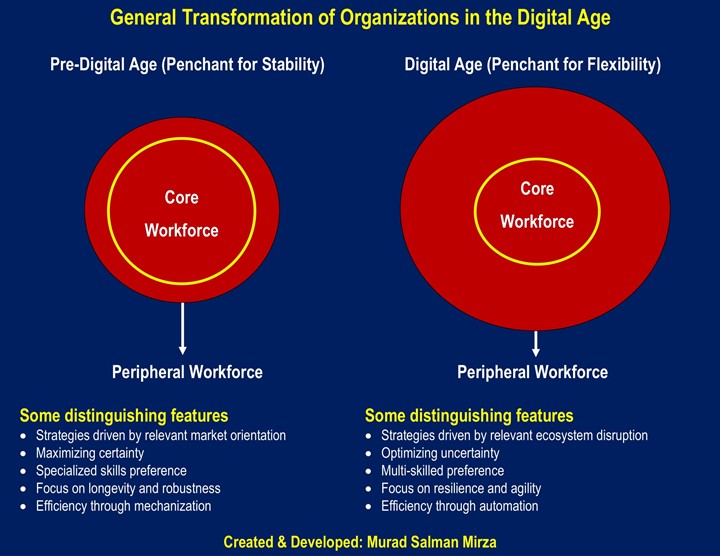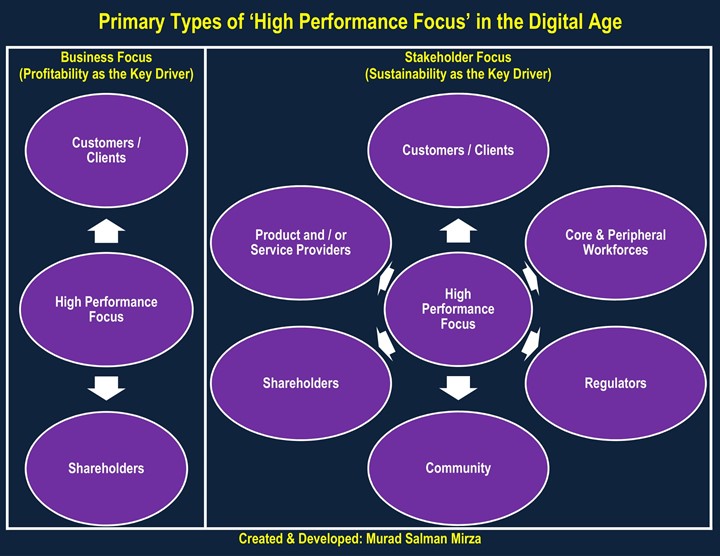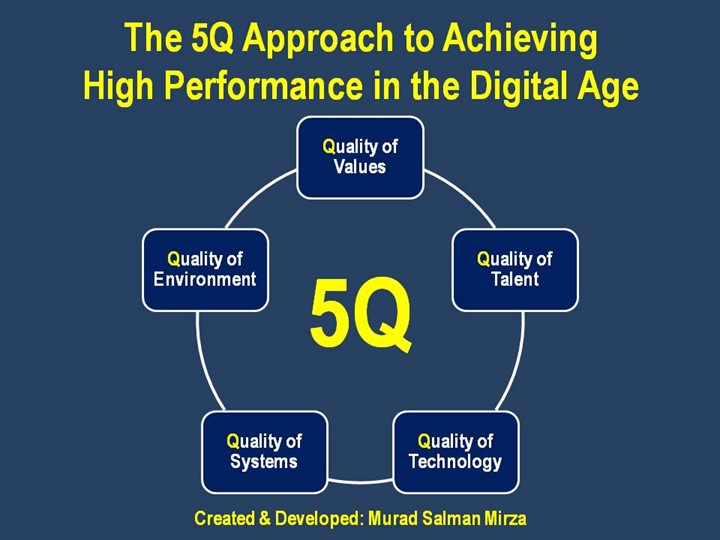(Sustaining Competitiveness by Assuring Relevance and Resilience)
Relevancy in the Digital Age is fraught with uncertainties and organizations often struggle with the conundrum of High Performance in order to maintain their competitive stature. The specter of being ‘outmaneuvered’ by wily competitors and/or being ‘blindsided’ by savvy disruptors is a nagging concern for progressive organizations that are well-aware of the steep price for chronic complacency and shallow resilience. This often manifests in the form of ‘corporate exhaustion’ resulting from constant vigilance to stay ahead of the evolving nature of the fickle markets driven by increasingly fastidious stakeholders.
Consequently, there is a conscious effort to sustain efficiency levels by minimizing/reducing exposure to seen/unforeseen risk pertaining to operational capability. One of the impacts of such an approach to ‘risk management’ has been in terms of trading stability (maintaining a large ‘core’ workforce and having a small ‘peripheral’ workforce) with flexibility (maintaining a large ‘peripheral’ workforce and having a small ‘core’ workforce) while feverishly embracing automation (wherever possible) as the ultimate panacea for avoiding complications relating to maintaining a ‘humanistic’ workforce. The following chart depicts the respective shift in priorities:

The requisite standards of corporate leadership are also evolving/increasing (https://lnkd.in/eCGbMpBy) to ‘match’ the challenges faced by organizations in order to proactively avoid any nightmarish scenarios pertaining to relevancy and competitiveness, especially, during precarious/turbulent times, e.g., the COVID-19 pandemic that rigorously tested the resilience of even the most ‘established’ business entities. The key aspect in the respective context to consider is that ‘High Performance’ drives ‘High Expectations’ and can lead to ‘High Satisfaction’ or ‘High Dissatisfaction’ depending upon the ability of the organization to deliver on its stated and/or perceived promises even under ‘abnormal’ conditions. There are two primary types of ‘High Performance Focus’ in the Digital Age that can be seen in the following chart:

Business Focus
This type of focus is embraced by businesses that are driven by the need for maximizing profitability (https://lnkd.in/g3Sbvmgs). Their path for achieving such an objective is by fulfilling the needs/expectations of their Shareholders and Customers/Clients. They are willing to marginalize/sacrifice the interests of other stakeholders to assure/ensure maintenance of the desired profitability margins. These organizations are generally seen in a negative light within the professional circles as being ‘habitual exploiters of talent’ and notorious ‘benders of the law’, while, their reputations are often tarnished by validated claims of favoring Machiavellian tactics in terms of ‘monopolistic’ or ‘cartelistic’ practices. Paradoxically, such organizations are often seen as ‘leaders’ of their industry.
Stakeholder Focus
This type of focus is embraced by businesses that are driven by the need for assuring sustainability (https://lnkd.in/eVcUKAqP). Their path for achieving such an objective is by fulfilling the needs/expectations of all their Stakeholders. They prefer to engage in and/or associate with ‘social entrepreneurship’ initiatives as a viable approach for achieving long-term success by being ‘valued’ members of society. These organizations are generally seen in a positive light within the professional circles as being ‘habitual benefactors of talent’ and cherished ‘upholders of the law’, while, their reputations are often exemplified by validated observations of favoring ‘communal good’ and ‘healthy competition’ over nefarious tactics. Paradoxically, such organizations are often seen as ‘rebels’ of their industry.
Organizations engaged in the aforementioned types of ‘High Performance Focus’ often combine several enabling factors in their quest to achieve the desired strategic and operational goals/objectives, e.g.:
- Refining and Improving the Quality of Leadership, especially, in terms of Capabilities Pertaining to Sound Decision-Making
- Developing Robust Talent Pipelines that can Effectively Replenish Positions/Roles that have been Vacated due to Expected/Unexpected Attrition
- Recognized Presence, Conscientious Development, Astute Deployment and Resourceful Optimization of Available Talent
- Robust Alignment of Personal and Professional Objectives of the Multigenerational Workforce with the Organizational Imperatives
- Intrinsically-Driven High Engagement and Corporate Citizenship by an ‘Invested’ Workforce
- Timely Pivoting/Congruity of Strategic and Operational Imperatives with the Evolution of Stakeholder Needs and Expectations
- Proactive Risk Management to Strengthen Inherent Resilience Against Foreseen/Unforeseen Challenges
- Agile Adherence to Ecosystem Dynamics
- Sincere Institutionalization of DIBE Initiatives
- Balanced Approach to the Induction and Utilization of ‘Needed’ Technology
- Unrelenting Focus on Assuring/Ensuring Delightful Experiences for Internal and External Customers
- Unflinching Approach/Support to Progressive Transformation with a Clear ‘Mandate’ on Desired Results
However, such progressive initiatives often lack the necessary guiding principles that can provide a viable and durable path for bundling performance measures in a systematic and result-oriented fashion. Consequently, the following 5Q Approach is being presented to facilitate sustainable success in achieving High Performance goals/objectives in the Digital Age:
High Performance (5Q) = QV + QE + QT1 + QS + QT2
Quality of Values (QV)
This refers to the high standards pertaining to creating, developing, achieving, maintaining and safeguarding the foundational elements of ‘goodness’ within the organization. It requires the robust resolve of an ‘honestly’ committed leadership (https://lnkd.in/eCGbMpBy) that serves as a ‘custodian’ of such virtues in terms of leading by example and proactively takes steps in assuring/ensuring the ingraining of ‘infectious positivity’ at the workplace as the cornerstone of a vibrant and galvanizing culture. It also demands constant and consistent vigilance in terms of neutralizing any attempts to dilute/dampen/disparage the benefits accrued in the context of organizational harmony from Machiavellian segments of the workforce. It is important to remember that an ‘Inspiration-based’ approach is generally a more enduring option that an ‘Aspiration-based’ approach for assuring ‘Sustainable Employee Engagement’ due to a more refined and durable way of leveraging the synergies between luminous foresight, astute decisiveness, coalescing culture, invigorating work environment, unambiguous empowerment, seamless compliance, timely execution, impartial self-reflection and the undeterred resilience to ensure effective remedial measures (https://lnkd.in/gMEAAz6w). Furthermore, a critical aspect of sustaining the ‘Quality of Values’ relates to the timely and effective feedback from the employees and subsequent ‘painstaking’ management reviews for assessing continued suitability/viability and taking the requisite corrective/preventive actions by allocating/deploying/utilizing the necessary resources judiciously.
Quality of Environment (QE)
This refers to the high standards pertaining to leveraging the characteristics of the internal (workplace) and external (ecosystem) environments. It requires a blissful marriage between the short-term and long-term corporate goals/objectives that reflect an astute cognizance of the various influential environmental factors. It entails the development of astute strategies that reflect a clear realization/accommodation of the controllable and uncontrollable factors relating to both kinds of environments in congruence with feasible operational plans that are peppered with ‘achievement markers’ at appropriate intervals. Care needs to be taken that any utilization of appropriate tools/techniques (e.g., SWOT Analysis, PESTLE Analysis, Balanced Scorecard, Employee Surveys, Customer Feedback, Organizational Audit, etc.) should not become a wasteful ‘paper churning’ exercise or be relegated to gathering dust in a ‘forgotten’ cabinet drawer. Additionally, concerns for the degradation of nature and social imbalances have added extra dimensions for competitive organizations to proactively engage in remedial measures before irreparable harm to increasingly fragile reputations. The term ‘activist’ has shifted from its rudimentary contemplation as an act of defiance to a more apt description of an ‘engaged’ stakeholder. Therefore, organizations with an eye on thriving in the future are well-advised to heed the adage ‘someone is always watching’ and proactively embrace the consequences of their actions/operations in a more accommodating and responsible manner as valued members of their surrounding communities.
Quality of Talent (QT1)
This refers to the high standards pertaining to acquiring, assimilating, managing, developing and optimizing talent (https://lnkd.in/dPS_Rsw3). Such measures have become inextricably linked with the survival of organizations in terms of staying relevant and competitive in the ruthlessly unforgiving corporate landscape of the Digital Age where ‘formidable competitors’ and ‘astute disruptors’ are a constant threat to seemingly ‘secure’ market positions. It requires the institutionalization of ‘Total Rewards’ that goes beyond the norms of conventional compensation, e.g., salary, benefits, rewards/recognition, bonuses, career advancement opportunities, etc., and inculcates an ‘Invigorating Employee Experience’ (https://lnkd.in/evkNUirQ) within the employee lifecycle. The significance of such measures is amplified during precarious economic situations, especially, resulting from unforeseen circumstances, e.g., the COVID-19 pandemic, when the call for ‘all hands on deck’ reverberates throughout the organization and everyone is expected to ‘do their part’ with the best traits of corporate citizenship in overcoming the daunting challenges. It is important to remember that short-sighted organizations often implement talent management practices that are designed for ‘risk accommodation’ against ‘talent flight’ instead of ‘risk mitigation’ that caters to ‘talent engagement’. Consequently, the sagaciousness of leadership in creating the ‘right conditions’ for retaining/nurturing desired talent and strengthening ‘talent pipelines’ as a nursery for generating capable successors for senior/top positions can signify to all the stakeholders whether the organization is a ‘thriving’ trailblazer that serves a ‘magnet’ for current/future talent, or, a ‘declining’ dinosaur that is perennially cursed with the ‘catastrophic depletion’ and ‘callous exploitation’ of promising talent.
Quality of Systems (QS)
This refers to the high standards pertaining to the design, development, and deployment of management systems. It requires the formulation of policies/processes/procedures/practices that reflect the foresight and astuteness of the organizational leadership in terms of assuring and ensuring the ‘going concern’ status of the organization in ‘normal’ and ‘abnormal’ circumstances. It also necessitates the imperative of embedding effective monitoring, review and improvement mechanisms within the relevant management systems so that there is uniform clarity within the corporate hierarchy with respect to organizational/functional structuring and judicious delineation/delegation of associated roles/responsibilities/authorities/accountabilities. It demands the delicate and discernible balance between robustness (reflecting the ability to accommodate the variability within situations pertaining to the prevailing business environment) and agility (reflecting the ability to timely pivot for accommodating the variability within situations pertaining to the changes in the applicable ecosystem). An important step in the respective context is to accommodate/assimilate/address the views/perspectives/concerns from all the segments of the multigenerational workforce to cater for the DIBE (Diversity, Inclusion, Belonging and Equity) factors in a prudent, foresightful and effective manner.
Quality of Technology (QT2)
This refers to the high standards pertaining to the procurement and deployment of suitable technological solutions within the workplace. It entails exhaustive analysis of key factors, e.g., the areas/functions that can significantly benefit from the induction/upgradation of technology, available options in the market, relevant impact of each option on the organization, especially, in terms of associated human, technical, maintenance and financial considerations (https://lnkd.in/fpWWMj9), etc., before formulating the necessary guidelines/recommendations for enabling the leadership to take a ‘sound’ acquisition decision. Care must be taken in terms of not sacrificing effectiveness at the altar of efficiency by succumbing to the lure of pervasive user-friendly technology at the cost of marginalizing human ingenuity in devising innovative solutions to overcome present and future organizational challenges. Another worrying factor in the respective context is that ‘unfettered and imprudent’ technological encroachments (https://lnkd.in/e8PzGr7w) are significantly increasing the depreciation rates of human assets in parched organizations yearning for ‘continuous’ innovation while consistently undermining the efficacy of employee engagement initiatives (https://lnkd.in/e8W6cMpJ).
It is wise to remember that mechanized ‘Performance Management’ has the unfortunate side effect of producing performers who are ‘character actors’ skilled in ‘gaming the system’, rather than, genuine practitioners of their fields dedicated to the cause of excellence. This is generally seen in hypercompetitive organizations that excessively rely on KPIs/KRAs for increasing efficiencies, however, it frequently blinds them to the systematic degradation of humanistic concerns of their employees (https://lnkd.in/eUbUQuZs).
Furthermore, it has also been commonly observed that considerable effort is put into a skewed review in terms of deciding the failure/future of an employee to meet the expectations of an organization. A more balanced and judicious approach would be to do a similar analysis on how the organization has failed the employee for leading to an untenable situation where an employment relationship is no longer deemed feasible for relevant parties.
Food for Thought
Mediocrity often reigns as ‘Excellence’ in businesses used to prospering in the absence of worthy competitors. Consequently, strong/opportunistic competitors and disruptive/agile entrants to the market are essential for designing/developing/deploying ‘High Performance’ organizations, especially, in the Digital Age, since they provide credible benchmarks for sustaining competitiveness by assuring relevance and resilience. The last thing an organization needs is a march towards oblivion as a consequence of floating in the serene calmness of complacency emanating from the assuring sense of past achievements as a Monopoly/Duopoly/Cartel. Are you prepared for the challenge?








